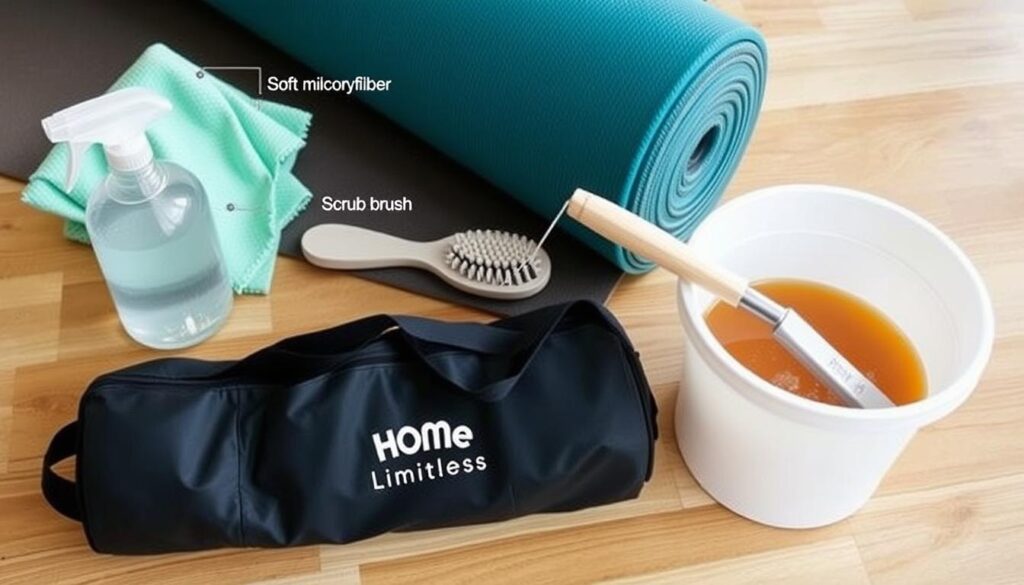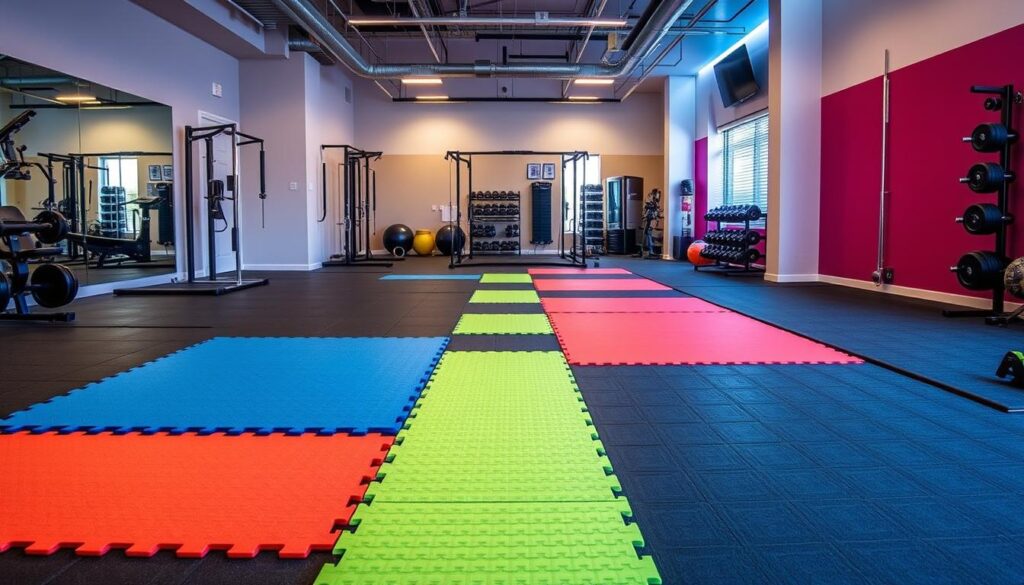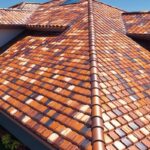Did you know gym mats can have up to 100 times more bacteria than a toilet seat? This fact shows how important it is to clean and maintain your home workout mats. Whether you have rubber, foam, or vinyl-topped mats, keeping them clean is key for your health and the mat’s life.
Gym mats for home use vary in materials and sizes, each needing special care. Cleaning them involves more than just a quick wipe. Let’s explore how to keep your exercise area clean and welcoming.
Cleaning your mats properly stops germs from spreading and makes them last longer. Whether it’s sweat-soaked rubber or dusty foam, regular care is essential. By using the right cleaning methods and products, your mats will stay in great shape. This ensures a safe and clean space for your workouts.
Table of Contents
Key Takeaways
- Regular cleaning prevents bacterial growth on gym mats
- Different mat materials require specific cleaning methods
- pH-neutral cleaners are best for most gym mat types
- Avoid harsh chemicals that can damage mat surfaces
- Proper maintenance extends the life of home workout mats
- Frequent cleaning is crucial for high-traffic areas
Understanding the Importance of Clean Gym Mats
Clean gym mats are key for a safe and effective workout area. Whether you’re using Yoga Mats or Fitness Floor Mats, keeping them clean is vital for your health and the mat’s life span.
Health and Hygiene Benefits
Regular cleaning stops bacteria from growing and keeps your workout area clean. This is very important for Yoga Mats, as they touch your skin. Clean mats lower the chance of skin infections and allergic reactions, making your exercise routine healthier.
Prolonging Equipment Life
Proper care makes your Fitness Floor Mats last longer. Cleaning them removes sweat, dirt, and oils that can damage the mat. This care keeps the mat’s shock-absorbing properties and function in top shape.
Enhancing Workout Experience
Clean gym mats make your workout better. They offer better grip, cut down on smells, and look nice. This makes your workout space more inviting, boosting your motivation and helping you stick to your exercise plan.
| Mat Type | Best Use | Cleaning Frequency |
|---|---|---|
| Rubber Mats | Weight rooms, high-traffic areas | Daily wipe-down, weekly deep clean |
| Foam Mats | Yoga, Pilates studios | After each use, weekly sanitization |
| PVC Mats | Various fitness activities | Daily spot cleaning, bi-weekly deep clean |
By focusing on cleanliness, you make your workout space safer, cleaner, and more welcoming. This supports your fitness goals and protects your investment in quality gym equipment.
Types of Gym Mats for Home Use
Choosing the right gym flooring is key for a safe workout space. Home gyms need different mats for various workouts and space.
Rubber mats are durable and easy to care for. They’re great for weight training and machines. Foam mats are soft for aerobics and protect joints. PVC tiles are versatile for light training and aerobics.
Interlocking mats are easy to set up and customize. They fit over low-pile carpet, ideal for home gyms. They’re made of rubber, foam, and PVC.
| Mat Type | Best For | Thickness |
|---|---|---|
| Rubber | Weightlifting | 3/4″ – 2″ |
| Foam | Aerobics | 1/2″ – 5/8″ |
| PVC | Lightweight Training | 1/4″ – 1/2″ |
Think about the mat’s purpose, size, durability, and cushioning when choosing. For heavy lifting, choose thick rubber mats. For easy transport, 1/2-inch mats are better.
- Yoga mats for flexibility exercises
- Carpet-topped mats for aesthetic appeal
- High-density foam for MMA and grappling
Regular care can make your gym mats last longer. Most mats last 1 to 5 years, based on use and quality.
Essential Cleaning Tools and Materials
Keeping your Portable Exercise Mats and Non-Slip Mats clean is key for a clean workout space. Let’s look at the cleaning tools and solutions you need for upkeep.
Recommended Cleaning Solutions
Use pH-neutral cleaners for your gym mats. A mix of dish soap and warm water is a good choice. Stay away from cleaners with solvents or oils, as they can harm rubber floors. For extra cleaning power, try EPA-approved products like Rochester Midland Environ Care Neutral Disinfectant, which fights COVID-19.
Necessary Equipment for Effective Cleaning
Get the right tools for a deep clean of your Non-Slip Mats:
- Broom or vacuum for initial debris removal
- 22″ Micro-Fiber Mat Mop for efficient cleaning
- Soft-bristle scrubbing brush for stubborn dirt
- Bucket for cleaning solution

The 22″ Micro-Fiber Mat Mop is a big help for cleaning Portable Exercise Mats. It can clean 1000 sq. ft. in under 5 minutes, using much less solution than old mops. Its head can be replaced up to 200 times, saving you money.
| Equipment | Benefits |
|---|---|
| Micro-Fiber Mat Mop | Efficient, eco-friendly, reusable |
| Zebra Mat Backpack Vacuum | Long motor life, consistent suction |
| Gym Wellness Wipes | Quick surface cleaning, enhances hygiene |
For big gym areas, an automatic Gym Scrubber is great for deep cleaning without harming mats. The Zebra Mat Backpack Vacuum, with its long-lasting motor, ensures your Portable Exercise Mats are clean.
Pre-Cleaning Preparation Steps
Before you start cleaning your Cushioned Exercise Mats, make sure the area is clear. This gives you enough space to clean without any obstacles. It also helps prevent spills from reaching other gym equipment.
Now, gather your cleaning tools. You’ll need:
- Broom or vacuum cleaner
- Mild detergent or mat cleaner
- Soft-bristle brush
- Bucket of warm water
- Microfiber cloth or mop
- Protective gloves
Start by sweeping or vacuuming your mats. Use a vacuum without a beater brush to avoid damage. This step removes dirt and debris, making the cleaning process more effective.
Next, mix a cleaning solution in a bucket. Use warm water and a mild detergent or a rubber mat cleaner for the best results. Stay away from harsh chemicals that could harm your mats.
| Cleaning Frequency | Area Type |
|---|---|
| Daily | High-traffic zones |
| Weekly | Low-traffic areas |
| Immediate | Spills and stains |
Regular cleaning keeps your mats in good condition and makes your workouts safer. By preparing well, you’re ready for a thorough and effective cleaning.
Deep Cleaning Techniques for Different Mat Materials
Keeping your gym mats clean is important for a healthy workout area. Each material needs its own cleaning method to stay in good shape. Let’s look at how to clean different types of exercise mats.
Rubber Mat Cleaning Methods
Rubber gym mats are tough and great for busy spots. Clean them with a damp cloth or mop and a mild cleaner. A mix of water and vinegar is good. Don’t soak the mat to avoid damage.
Vacuum often to get rid of dirt and dust.
Foam Mat Cleaning Procedures
Foam mats need gentle care to keep them soft. Clean with a soft cloth and mild soap and water. Stay away from strong chemicals that can harm the foam.
For tough smells, try water and white vinegar. Always let them dry completely before using again.
Vinyl Mat Maintenance Tips
Vinyl mats are easy to clean because they resist water. Wipe them with a disinfectant after each workout. For a deep clean, use a damp cloth and mild detergent.
Rinse well and dry completely to stop mold. Don’t use rough cleaners that can scratch the vinyl.
Regular care is essential for your gym mats. Vacuum often, especially in busy areas. Always check the manufacturer’s advice for the best cleaning and to keep the warranty valid.
Daily Maintenance Routines for Gym Mats
Keeping your home workout mats clean is key for a safe and healthy workout space. Regular care of your fitness floor mats extends their life and keeps them working well during your workouts.
Begin by sweeping or vacuuming your gym mats to get rid of loose dirt and debris. This easy step stops dirt from building up and keeps the mat’s grip strong. If your mats get a lot of use, clean them more often.
Spot cleaning is important for stains or spills. Use a damp cloth with a mild cleanser to clean the spots. Stay away from harsh chemicals that can harm the mat.
Here’s a quick guide for daily mat maintenance:
- Sweep or vacuum thoroughly
- Wipe down with a damp cloth
- Spot clean visible stains
- Inspect for signs of wear or damage
For rubber gym mats, which are great for home gyms because they last long, use a low-foam, all-purpose cleaner. This keeps them clean without hurting the mat.
| Mat Type | Daily Cleaning Method | Weekly Deep Clean |
|---|---|---|
| Rubber | Sweep, damp mop | Neutral pH cleaner, scrub |
| Foam | Vacuum, wipe down | Mild soap solution, air dry |
| Vinyl | Dry mop, spot clean | Disinfectant spray, wipe |
Prevention is important. Put doormats at entrances to stop dirt from getting on your mats. Clean spills right away to avoid stains. With these easy steps, your home workout mats will stay in great shape, helping you on your fitness path for years.
Addressing Common Stains and Odors
Keeping your Yoga Mats and Non-Slip Mats clean is key to a great workout. Let’s look at how to tackle common issues that pop up with gym mats.
Sweat and Body Oil Removal
Sweat and oils build up fast on gym mats. To clean, mix mild soap with warm water. Dab the solution on the mat with a soft cloth.
Rinse with clean water and dry well. This keeps your mats fresh and stops germs from growing.
Eliminating Unpleasant Odors
Bad smells can make workouts less fun. Mix equal parts water and white vinegar in a spray bottle. Spritz your mats and wipe down.
The vinegar smell goes away as it dries, taking bad odors with it. For tougher smells, try a special mat cleaner.
Tackling Stubborn Stains
For tough stains on Non-Slip Mats, use a soft brush and the right cleaner. Test any new cleaner on a small spot first. Scrub gently in circles, then rinse and dry.
This method works well for most gym mat stains.
Clean your mats often to keep them in top shape. A weekly deep clean helps your mats last longer. Remember, clean mats mean safer, more enjoyable workouts!
Proper Storage and Handling of Gym Mats
Storing your gym mats right is crucial for their quality and life span. For Portable Exercise Mats, keep them in a cool, dry place away from sunlight. This stops them from warping or changing color. Roll or stack them neatly to avoid creases or damage.
Interlocking Mats need extra care. Take them apart before storing and clean each piece well. Make sure they’re dry to stop mold from growing. This is key for keeping your home fitness system clean.
Here are some quick tips for proper mat storage:
- Use wall-mounted racks to save floor space
- Store mats vertically to prevent sagging
- Keep heavy mats on lower shelves for safety
- Use breathable covers to protect from dust
Proper storage keeps your mats in great shape and ensures a clean workout space. This care can make your mats last longer, saving you money.
“A well-maintained mat is the foundation of a safe and effective workout.”
By following these storage tips, you’ll make your exercise space safer. You’ll also get the most from your gym equipment. Your future self will appreciate the effort you put into caring for your fitness gear.
Gym Mats for Home: Choosing the Right Type for Easy Maintenance
Choosing the right gym flooring for your home is key for easy upkeep and lasting use. Cushioned exercise mats vary in material, each with its own benefits and care needs.

Rubber mats are a top pick for home gyms. They’re tough, simple to clean, and affordable, costing $3 to $8 per square foot. You can find rubber flooring in tiles, rolls, and interlocking mats. They come in thicknesses from 4mm to 50mm, fitting different workout levels.
Foam tiles provide a softer surface, great for low-impact exercises. They cost between $0.50 to $2.50 per square foot, making them a budget-friendly option. Tatami foam puzzle mats, available in 20mm and 40mm thicknesses, are ideal for yoga and martial arts.
| Flooring Type | Cost per sq ft | Thickness Range | Best For |
|---|---|---|---|
| Rubber | $3 – $8 | 4mm – 50mm | High-impact, weights |
| Foam | $0.50 – $2.50 | 20mm – 40mm | Low-impact, yoga |
| Vinyl | $2 – $7 | Varies | All-purpose |
| Artificial Turf | $3 – $6 | Varies | High-intensity workouts |
Vinyl flooring ($2 to $7 per square foot) is versatile and easy to maintain. Artificial turf ($3 to $6 per square foot) is also popular for its dynamic feel and suitability for intense workouts.
Think about the exercises you’ll do, the equipment you’ll use, and your cleaning habits when picking gym flooring. Look for mats with antimicrobial properties for better hygiene, especially in moist areas.
Conclusion
Getting quality gym mats for home workouts is a big step for fitness lovers. These mats provide a safe, comfy, and clean spot for many exercises. They also prevent slipping and protect your joints during tough workouts.
It’s important to keep your gym mats in good shape. Regular cleaning and care make them last longer and keep your gym clean. By following the right cleaning methods for each mat type, you can keep your space welcoming and clean.
Choosing between foam or rubber mats depends on your needs. Foam mats are light, flexible, and great for bodyweight exercises and stretching. Rubber mats, though more expensive, are durable and quiet, perfect for heavy equipment and intense sessions. Picking the right mat and taking good care of it will make your home gym safe and lasting.







